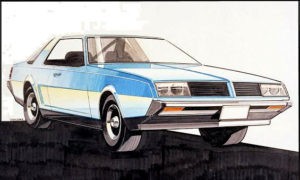The Mitsubishi Lambda, also known as the Dodge Challenger and Plymouth Sapporo in the North American market, was a groundbreaking vehicle with a unique design story. This article delves into the creation of this iconic coupe, exploring the challenges and triumphs of its development, focusing on the design evolution of the Mitsubishi Lambda.
The Birth of a Unique Silhouette: Balancing Fastback and Notchback
The Lambda’s design journey began as a variation of the Galant Sigma. Early proposals included both fastback and notchback styles, with some sharing the Sigma’s front end. However, the desire for a distinct identity led to a full skin change proposal, embracing the sporty legacy of the Galant GTO.
Early clay model of a fastback Lambda proposal.
Designer Ryu Kaibuchi was tasked with creating a design that blurred the lines between fastback and notchback. His solution was a semi-fastback silhouette featuring a distinctive C-pillar reminiscent of a roll bar, giving a nod to the notchback style. This innovative approach resulted in the Lambda’s signature look.
Clay model showcasing Kaibuchi’s innovative design.
A Bold Front End: Embracing New Technologies and Trends
The Lambda’s front end was equally revolutionary. It featured a slanted nose, a rarity in Japanese cars at the time, and initially incorporated two rectangular headlights, later updated to four to meet North American SAE standards. A distinctive body-colored center nose further set it apart.
Early design sketch showcasing the two rectangular headlight configuration.
However, due to sales strategies and Chrysler’s influence, the center nose was eventually removed. Despite this compromise, the Lambda retained its unique slanted nose and rectangular headlights, establishing a strong visual identity.
Design proposal showcasing a shared nose design with the Sigma.
The Iconic Wraparound Rear Window: A Triumph of Engineering
One of the Lambda’s most striking features was its wraparound rear window. Initially envisioned as a three-part structure due to technological limitations, Mitsubishi collaborated with Asahi Glass to create a single-piece curved glass.
Initial design featuring a three-part rear window.
This groundbreaking achievement not only enhanced the Lambda’s aesthetic appeal but also pushed the boundaries of automotive glass design in Japan.
Clay model highlighting the distinctive rear window design.
A Lasting Legacy: The Mitsubishi Lambda’s Impact
The Mitsubishi Lambda made a significant impact on the automotive landscape. Its distinctive design, innovative features, and successful partnership with Chrysler solidified its place as a memorable and influential vehicle. The Lambda’s unique design language paved the way for future Mitsubishi models and showcased the company’s commitment to pushing boundaries. Its blend of sporty styling and innovative engineering continues to resonate with car enthusiasts today. The Lambda’s story is a testament to the power of collaboration, innovation, and a bold vision.
